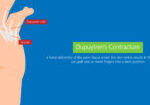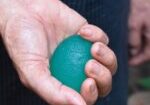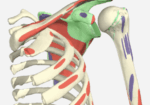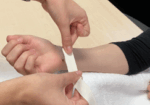隔间 综合征是一种以体内某个部位的压力升高为特征的疾病,导致疼痛、肿胀和组织灌注减少 (Barkay 等人,2021;Buerba 等人,2019)。该综合征可分为急性和慢性 (Barkay 等人,2021)。慢性劳损性 隔间 筋膜间质综合征 (CECS) 是一种罕见类型,最常见于运动员,尤其是赛艇运动员和摩托车运动员,通常累及上肢,但任何人都可能发生 (Buerba et al., 2019; Cole et al., 2017)。CECS 的特征是筋膜间质内压力逐渐且可逆性地增加,导致进行性疼痛和水肿,通常由活动诱发。这是由于肌肉肥大、微创伤和肌膜顺应性差 (Buerba et al., 2019; Ogrodnik et al., 2021)。患者经常报告持续性疼痛,并会因重复性动作而加剧 (Cole et al., 2017)。
CECS 的治疗方案
CECS 通常采用保守治疗,但如果症状持续并影响日常活动,则可以选择手术治疗。
保守治疗
保守治疗通常包括按摩、拉伸和活动调整(Buerba 等人,2019 年)。
手法治疗:
就按摩和拉伸技巧而言,一项为期五周的按摩疗程和家庭拉伸锻炼计划已被证实可以减轻运动后疼痛 (Blackman 等人,1998)。一项研究得出结论,这是由于按摩后筋膜拉伸导致的肌肉隔室容积增加,或是由于筋膜神经受体改变或肌肉变化导致个体疼痛阈值升高 (Blackman 等人,1998)。
生物反馈:
治疗这种综合症的一个方法是提供活动调整教育。此外,慢性 隔间 这种综合征通常被称为慢性运动性筋膜室综合征,因为它通常由运动引起 (Buerba 等人,2019)。这是通过在活动调整和再训练干预期间提供生物反馈来实现的 (M. Materi,个人通信,2023 年 9 月 14 日;Zimmerman 等人,2017)。生物反馈提供有关肌肉隔室所施加力量的视觉反馈 (Larsen 等人,2014;M. Materi,个人通信,2023 年 9 月 14 日)。
图1:mTrigger生物反馈设备 图2:mTrigger生物反馈设备
https://www.mtrigger.com/biofeedback-occupational-hand-therapy/

握把:
此外,更大的手柄有助于调整活动(M. Materi,个人通信,2023年9月14日)。由于慢性运动性筋膜室综合征常见于赛艇运动员和摩托车手,而这些职业需要高强度的握力和持续使用,因此,设计更大的手柄可以调节抓握物体所需的握力(Buerba等人,2019年;M. Materi,个人通信,2023年9月14日;Sheerin等人,2023年)。更换手柄会改变患者在活动中施加的力量和姿势,从而改变他们一直以来的重复性动作(M. Materi,个人通信,2023年9月14日;Zimmerman等人,2017年;Schubert,2011年)。
图 2:组合手柄

总体而言,慢性运动性筋膜间隔综合征可以保守治疗,但如果症状持续并影响日常生活,患者可以选择接受筋膜切开术。
参考
Barkay, G.、Zabatani, A.、Menachem, S.、Yaffe, B. 和 Arami, A. (2021)。上肢急性筋膜室综合征:手术治疗后的临床结局。一项回顾性队列研究。 《以色列医学协会杂志》,23(8), 516–520。
Blackman, PG, Simmons, LR, & Crossley, KM (1998).按摩治疗慢性劳累性前侧筋膜室综合征:一项初步研究。 《运动医学临床杂志》, 8(1),14–17。https://doi.org/
Buerba, RA、Fretes, NF、Devana, SK 和 Beck, JJ (2019)。慢性运动筋膜室综合征:目前的治疗策略。 开放获取运动医学杂志, 2019(10),71-79。
Cole, A., Hiatt, JL, Arnold, C., Sites, T., & Ylanon, R. (2017).大学垒球投手前臂慢性运动性筋膜间隔综合征。 运动医学 – 公开组, 3(1), 11.
Larsen, CM、Juul-Kristensen, B.、Olsen, HB、Holtermann, A. 和 Søgaard, K. (2014)。肩峰下撞击综合征患者斜方肌内区域选择性激活。一项病例对照研究。肌电图和运动机能学杂志,24(1), 58–64。
Ogrodnik, J., Oliver, JD, Cani, D., Boczar, D., Huayllani, MT, Restrepo, DJ, Sisti, A., Manrique, OJ, Broer, PN, & Forte, AJ (2021).急性非创伤性手部筋膜间隔综合征临床病例及上肢系统评价。 手,16岁(3), 285–291。
Schubert, AG (2011).劳力性筋膜间隔室综合征:文献综述及手术松解后康复指南建议。 国际运动物理治疗杂志, 6(2), 126–141。
Sheerin, M., O'Riordan, C., Conneely, M., Carey, L., Ryan, D., Galvin, R., & Morrissey, AM (2023).职业治疗干预对手部、腕部和前臂疾病成年人功能和职业表现的有效性:系统评价与荟萃分析。 澳大利亚职业治疗杂志, 1-15.
Zimmermann, WO、Linschoten, CW 和 Beutler, A. (2017).步态再训练作为运动相关腿痛士兵治疗计划的一部分:初步临床经验与保留。 南非运动医学杂志, 29(1), 1-6.
更多阅读内容
胶原酶注射与部分筋膜切除术治疗掌腱膜挛缩症的比较
快速审稿人:Shruti Jani 标题:胶原酶注射与部分筋膜切除术治疗掌腱膜挛缩症参考:Tay, TKW, Tien, H., & Lim, EYL (2015)。胶原酶注射与部分筋膜切除术治疗掌腱膜挛缩症的比较。手外科,20(3), 386-390。 https://doi-org.mwu.idm.oclc.org/10.1142/S0218810415500288 The Skinny:“胶原酶注射液与……的比较
阅读更多Neurolutions IpsiHand 助力偏瘫患者中风康复
Neurolutions IpsiHand 助力偏瘫患者中风康复 约 77% 的新发中风病例会出现偏瘫,并且通常持续至慢性期 (Humphries 等人,2021)。脑机接口 (BCI) 等最新创新技术,即使在中风数年后也能为运动功能康复带来新的机会。Neurolutions IpsiHand 系统就是这样一种解决方案,它……
阅读更多注册即可直接将更新发送到您的收件箱!
注册我们,我们将定期向您发送有关手部治疗的所有内容的博客文章、每次上传新视频和教程时的通知,以及讲义、协议和其他有用信息。






